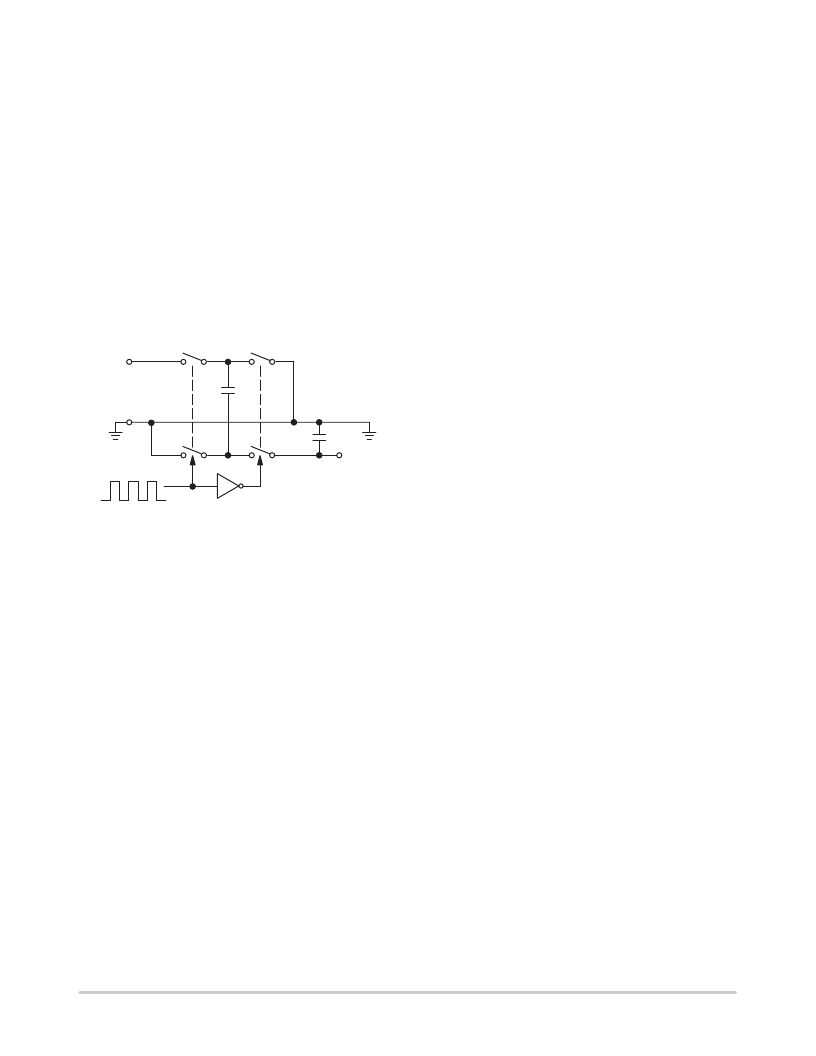- 您現(xiàn)在的位置:買賣IC網(wǎng) > PDF目錄382316 > MC7660 (ON SEMICONDUCTOR) Charge Pump DC-to-DC Voltage Converter PDF資料下載
參數(shù)資料
| 型號(hào): | MC7660 |
| 廠商: | ON SEMICONDUCTOR |
| 英文描述: | Charge Pump DC-to-DC Voltage Converter |
| 中文描述: | 電荷泵型DC - DC電壓轉(zhuǎn)換器 |
| 文件頁數(shù): | 3/12頁 |
| 文件大小: | 191K |
| 代理商: | MC7660 |

MC7660
http://onsemi.com
3
APPLICATIONS INFORMATION
Detailed Description
The MC7660 contains all the necessary circuitry to
implement a voltage inverter, with the exception of two
external capacitors, which may be inexpensive 10
μ
F
polarized electrolytic capacitors. Operation is best
understood by considering Figure 2, which shows an
idealized voltage inverter. Capacitor C
1
is charged to a
voltage, V
+
, for the half cycle when switches S
1
and S
3
are
closed. (
Note:
Switches S
2
and S
4
are open during this half
cycle.) During the second half cycle of operation, switches
S
2
and S
4
are closed, with S
1
and S
3
open, thereby shifting
capacitor C
1
negatively by V
+
volts. Charge is then
transferred from C
1
to C
2
, such that the voltage on C
2
is
exactly V
+
, assuming ideal switches and no load on C
2
.
V+
VOUT =
–VIN
GND
S1
S2
S3
S4
C2
Figure 2. Idealized Charge Pump Inverter
The four switches in Figure 2 are MOS power switches;
S
1
is a P–channel device, and S
2
, S
3
and S
4
are N–channel
devices. The main difficulty with this approach is that in
integrating the switches, the substrates of S
3
and S
4
must
always remain reverse–biased with respect to their sources,
but not so much as to degrade their ON resistances. In
addition, at circuit start–up, and under output short circuit
conditions (V
OUT
= V
+
), the output voltage must be sensed
and the substrate bias adjusted accordingly. Failure to
accomplish this will result in high power losses and probable
device latch–up.
This problem is eliminated in the MC7660 by a logic
network which senses the output voltage (V
OUT
) together
with the level translators, and switches the substrates of S
3
and S
4
to the correct level to maintain necessary reverse bias.
The voltage regulator portion of the MC7660 is an integral
part of the anti–latch–up circuitry. Its inherent voltage drop
C1
can, however, degrade operation at low voltages. To
improve low–voltage operation, the LV pin should be
connected to GND, disabling the regulator. For supply
voltages greater than 3.5V, the LV terminal must be left open
to ensure latch–up–proof operation and prevent device
damage.
Theoretical Power Efficiency Considerations
In theory, a capacitive charge pump can approach 100%
efficiency if certain conditions are met:
(1) The drive circuitry consumes minimal power.
(2) The output switches have extremely low ON
resistance and virtually no offset.
(3) The impedances of the pump and reservoir
capacitors are negligible at the pump frequency.
The MC7660 approaches these conditions for negative
voltage multiplication if large values of C
1
and C
2
are used.
Energy is lost only in the transfer of charge between
capacitors if a change in voltage occurs.
The energy lost
is defined by:
E = 1/2 C
1
(V
12
— V
22
)
V
1
and V
2
are the voltages on C
1
during the pump and
transfer cycles. If the impedances of C
1
and C
2
are relatively
high at the pump frequency (refer to Figure 2), compared to
the value of R
L
, there will be a substantial difference in
voltages V
1
and V
2
. Therefore, it is not only desirable to
make C
2
as large as possible to eliminate output voltage
ripple, but also to employ a correspondingly large value for
C
1
in order to achieve maximum efficiency of operation.
Dos and Don’ts
Do not exceed maximum supply voltages.
Do not connect LV terminal to GND for supply voltages
greater than 3.5V.
Do not short circuit the output to V
+
supply for voltages
above 5.5V for extended periods; however, transient
conditions including start–up are okay.
When using polarized capacitors in the inverting mode,
the + terminal of C
1
must be connected to pin 2 of the
MC7660 and the + terminal of C
2
must be connected to
GND Pin 3.
相關(guān)PDF資料 |
PDF描述 |
|---|---|
| MC78BC31NTR | Micropower Voltage Regulator |
| MC78BC43NTR | Micropower Voltage Regulator |
| MC78BC45NTR | Micropower Voltage Regulator |
| MC78L00D | 5.0 AMP POSITIVE VOLTAGE REGULATOR |
| MC78L08ABPG | 5.0 AMP POSITIVE VOLTAGE REGULATOR |
相關(guān)代理商/技術(shù)參數(shù) |
參數(shù)描述 |
|---|---|
| MC7660DR2 | 制造商:Rochester Electronics LLC 功能描述:- Bulk 制造商:ON Semiconductor 功能描述: |
| MC7700_1101346 | 制造商:Sierra Wireless 功能描述:4G/LTE MINI CARD |
| MC7700_1101366 | 制造商:Sierra Wireless 功能描述:4G/LTE MINI CARD |
| MC7700_1101367 | 制造商:Sierra Wireless 功能描述:4G/LTE MINI CARD |
| MC7700_1101404 | 制造商:Sierra Wireless 功能描述:4G/LTE MINI CARD |
發(fā)布緊急采購,3分鐘左右您將得到回復(fù)。